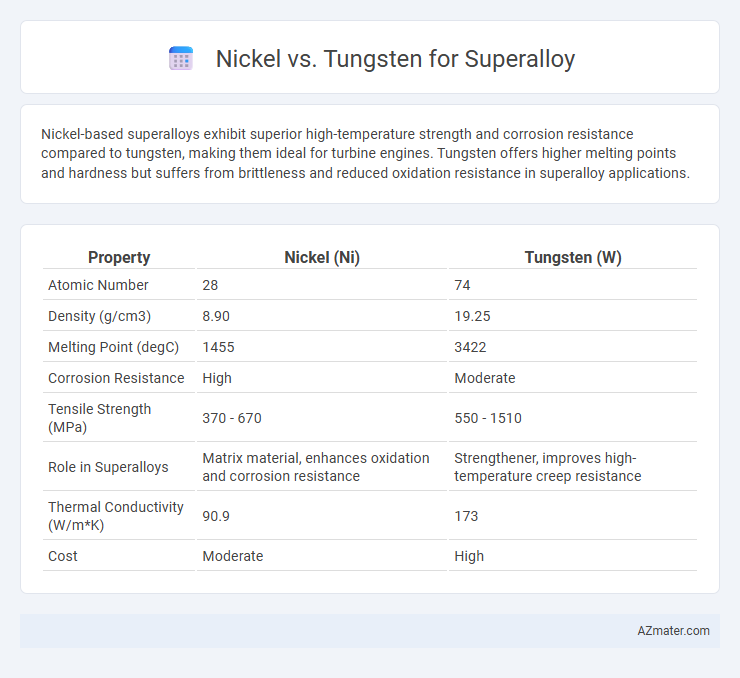Nickel-based superalloys exhibit superior high-temperature strength and corrosion resistance compared to tungsten, making them ideal for turbine engines. Tungsten offers higher melting points and hardness but suffers from brittleness and reduced oxidation resistance in superalloy applications.
Table of Comparison
| Property | Nickel (Ni) | Tungsten (W) |
|---|---|---|
| Atomic Number | 28 | 74 |
| Density (g/cm3) | 8.90 | 19.25 |
| Melting Point (degC) | 1455 | 3422 |
| Corrosion Resistance | High | Moderate |
| Tensile Strength (MPa) | 370 - 670 | 550 - 1510 |
| Role in Superalloys | Matrix material, enhances oxidation and corrosion resistance | Strengthener, improves high-temperature creep resistance |
| Thermal Conductivity (W/m*K) | 90.9 | 173 |
| Cost | Moderate | High |
Introduction to Superalloys
Superalloys are advanced materials designed for high-temperature applications, primarily in aerospace and power generation, where exceptional strength, corrosion resistance, and thermal stability are crucial. Nickel-based superalloys dominate the industry due to their excellent creep resistance and oxidation resistance at elevated temperatures. Tungsten, often used as an alloying element in superalloys, enhances hardness and high-temperature strength but is less common as a primary matrix compared to nickel.
Key Properties of Nickel-Based Superalloys
Nickel-based superalloys exhibit exceptional high-temperature strength, corrosion resistance, and oxidation resistance, making them ideal for aerospace and power generation turbines. These alloys maintain mechanical integrity at temperatures up to 1100degC, outperforming tungsten in creep resistance and thermal fatigue performance. Nickel's superior ability to form stable gamma-prime (g') precipitates enhances hardness and phase stability under extreme operating conditions where tungsten superalloys tend to suffer from brittleness and lower oxidation resistance.
Key Properties of Tungsten-Based Superalloys
Tungsten-based superalloys exhibit exceptional high-temperature strength, superior melting points exceeding 3400degC, and excellent thermal conductivity, making them ideal for extreme environments. Their resistance to oxidation and thermal creep deformation outperforms nickel-based alloys at temperatures above 1000degC. These key properties enable tungsten superalloys to maintain structural integrity in aerospace and turbine engine applications where thermal stability is critical.
Comparative Chemical Composition
Nickel-based superalloys typically contain 50-70% nickel along with chromium, cobalt, and molybdenum, providing excellent oxidation resistance and high-temperature strength. Tungsten superalloys, often combined with nickel and iron, have a higher tungsten content (up to 20%) that enhances hardness and wear resistance but reduces ductility. The critical distinction in chemical composition lies in nickel's dominance for corrosion resistance versus tungsten's role in improving mechanical reinforcement in superalloy matrices.
Mechanical Strength and Durability
Nickel-based superalloys exhibit superior mechanical strength and excellent high-temperature durability, making them the preferred choice for aerospace and turbine engine components. Tungsten, with its exceptional hardness and high melting point, enhances wear resistance and thermal stability when alloyed, but its brittleness limits ductility compared to nickel alloys. The optimal superalloy composition often balances nickel's toughness and tungsten's hardness to achieve enhanced overall mechanical performance and longevity under extreme conditions.
High-Temperature Performance
Nickel-based superalloys exhibit superior high-temperature performance due to their excellent oxidation resistance, creep strength, and phase stability at temperatures up to 1100degC, making them ideal for turbine blades and jet engines. Tungsten, while having a higher melting point of 3422degC, suffers from brittleness and oxidation issues, limiting its standalone use in high-temperature superalloy applications. Advanced superalloys often use nickel as the matrix with tungsten as an additive to enhance strength without compromising thermal stability.
Corrosion and Oxidation Resistance
Nickel-based superalloys exhibit superior corrosion resistance due to the stable formation of a protective oxide layer, primarily chromium oxide, which enhances durability in high-temperature oxidative environments. Tungsten, while offering excellent high-temperature strength, is more prone to oxidation and forms volatile tungsten oxides that degrade protective layers, reducing corrosion resistance. In harsh oxidative conditions, nickel superalloys are preferred for their ability to maintain structural integrity and resist corrosive degradation.
Applications of Nickel Superalloys
Nickel superalloys are extensively used in aerospace and power generation industries due to their exceptional high-temperature strength and corrosion resistance, outperforming tungsten-based alloys in turbine blades, jet engines, and gas turbines. These alloys maintain mechanical integrity at temperatures exceeding 1000degC, making them ideal for harsh environments where tungsten's brittleness limits performance. Nickel superalloys also dominate in chemical processing and nuclear reactors, where oxidation resistance and structural stability are critical.
Applications of Tungsten Superalloys
Tungsten superalloys are extensively used in aerospace and military industries for their exceptional high-temperature strength and resistance to thermal creep deformation. These alloys are ideal for turbine blades, rocket engine parts, and aerospace fasteners where thermal stability and durability are critical. Compared to nickel-based superalloys, tungsten superalloys offer superior melting points and wear resistance, making them indispensable in extreme environment applications.
Cost, Availability, and Environmental Impact
Nickel-based superalloys exhibit higher cost due to nickel's limited global reserves and complex refining processes, while tungsten offers more stable pricing supported by abundant deposits primarily in China and Russia. Availability challenges of nickel stem from geopolitical factors and extraction difficulties, whereas tungsten's supply chain risks include concentrated mining but benefit from extensive recycling efforts. Environmental impacts of nickel involve significant greenhouse gas emissions and toxic byproducts during refining, contrasting with tungsten which has lower emissions but concerns related to mining waste management and potential water contamination.

Infographic: Nickel vs Tungsten for Superalloy
 azmater.com
azmater.com